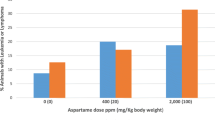Abstract
The effect of low copper and high zinc intakes on Cu,Zn-superoxide dismutase (Cu,Zn-SOD) activity and mammary tumorigenesis induced by 9,10-dimethyl-1,2-benzanthracene (DMBA) was investigated. Groups of 40 weanling female Sprague-Dawley rats were fed a modified AIN-76 diet containing the following (/kg diet): 1 mg Cu (0.016 mmol) and 30 mg Zn (0.459 mmol); 6 mg Cu (0.094 mmol) and 30 mg Zn (0.459 mmol) (control); or 6 mg Cu (0.094 mmol) and 150 mg Zn (2.295 mmol) for 21 wk. At 5 wk, 30 rats/group were given 4 mg (15.6 μmol) DMBA in corn oil intragastrically, and controls (10/group) received corn oil alone. Erythrocyte Cu,Zn-SOD activity was measured at 3, 5 (just before DMBA), 9, 13, 17, and 21 wk. The group fed the high-Zn diet had a slightly lower weight gain and food consumption. DMBA treatment had no effect on these parameters. Plasma and liver Cu concentration decreased in the low-Cu group. Femur zinc was significantly elevated in the high-Zn group. Erythrocyte Cu,Zn-SOD activity was decreased in the low-Cu group from 3 to 21 wk and was significantly elevated in the high-Zn group at 3 and 5 wk. In the low-Cu group, there were 5 nonmalignant adenomas and 3 malignant adenocarcinomas; in the control group, there were 4 adenomas and 3 adenocarcinomas; in the high-Zn group, there were 5 adenomas and 3 adenocarcinomas. No relationship between Cu,Zn-SOD activity and the presence of tumors could be found.
Similar content being viewed by others
References
C. Nagata, M. Kodama, Y. Ioki, and T. Kimura,Free Radicals and Cancer, R. A. Floyd, ed., Marcel Dekker, New York, 1982, pp. 1–62.
C. Nagata, M. Kodama, T. Kimura, and T. Nakayama, (1985),P-450 and Chemical Carcinogenesis, Gann Monograph on Cancer Research, No. 30, Y. Tagashira, and T. Omura, eds., Japan Scientific Societies Press, Tokyo, pp. 93–110.
M. Kodama, T. Nakayama, M. Kaneko, H. Saito, T. Oda, and Y. SatoMedical, Biochemical and Chemical Aspects of Free Radicals, vol. 2, O. Hayaishi, E. Niki, M. Kondo, T. Yoshikawa, eds., Elsevier, Amsterdam, 1989, pp. 1499–1502.
H. C. Birnboim,Carcinogenesis 7, 1511 (1986).
Y. Nakamura, T. D. Gindhart, D. Winterstein, I. Tomita, J. L. Seed, and N. H. Colburn,Carcinogenesis 9, 203 (1988).
U. Armato, P. G. Andreis, and F. Romano,Carcinogenesis 5, 1547 (1984).
E. D. Werts and M. N. Gould,Carcinogenesis 7, 1197 (1986).
P. W. F. Fischer, A. Giroux, and M. R. L'Abbé,Am. J. Clin. Nutr. 40, 743 (1984).
M. R. L'Abbé, and P. W. F. Fischer,J. Nutr. 114, 813 (1984).
American Institute of Nutrition,J. Nutr. 107, 1340 (1977).
American Institute of Nutrition,J. Nutr. 110, 1726 (1980).
S. Young, and R. C. Hallowes,Pathology of Tumors in Lab Animals. Tumors of the Rat, vol. 1. V. S. Turusov, ed., WHO, IARC, Lyon, 1973, pp. 31–74.
M. R. L'Abbé, P. W. F. Fischer, J. S. Campbell and E. R. Chavez,J. Nutr. 119, 757 (1989).
M. R. L'Abbé and P. W. F. Fischer,Clin. Biochem. 19, 175 (1986).
Center for Disease Control,Health Summary Report. Trace Metals Survey I. Dept of Health, Education and Welfare, Atlanta, 1976.
H. Ohkawa, N. Ohishi and K. Yagi,Anal. Biochem. 95, 351 (1979).
H. Kosugi, T. Kojima, and K. Kikugawa, Lipids24, 873 (1989).
G. W. Snedecor, and W. G. Cochran,Statistical Methods, 6rh ed. Iowa State University Press, Ames, IA, 1967, pp. 272–275.
M. R. L'Abbé and P. W. F. Fischer,J. Nutr. 114, 823 (1984).
P. W. F. Fischer, A. Giroux and M. R. L'Abbé,J. Nutr. 113, 462 (1983).
J. Z. Byczkowski, and T. Gessner,Gen. Pharmacol. 18, 385
J. Z. Byczkowski and T. Gessner,Int. J. Biochem. 19, 531 (1987).
M. L. Cunningham, J. G. Peak, and M. J. Peak,Mutat. Res. 184, 217 (1987).
C. Deby and R. Goutier,Biochem. Pharmacol. 39, 399 (1990).
G. Minotti, and S. D. Aust,Chem. Biol. Interact. 71, 1 (1989).
C. T. Dameron, and E. D. Harris,Biochem. J. 248, 669 (1987).
Author information
Authors and Affiliations
Additional information
A portion of these results were presented at the 74th FASEB Meeting, Washington, DC, April 1–5, 1990, Abstract 712. Publication No. 349 of the Bureau of Nutritional Sciences.
Rights and permissions
About this article
Cite this article
Fischer, P.W.F., Campbell, J.S. & Giroux, A. Effects of low copper and high zinc intakes and related changes in Cu,Zn-superoxide dismutase activity on DMBA-induced mammary tumorigenesis. Biol Trace Elem Res 30, 65–79 (1991). https://doi.org/10.1007/BF02990343
Received:
Accepted:
Issue Date:
DOI: https://doi.org/10.1007/BF02990343




